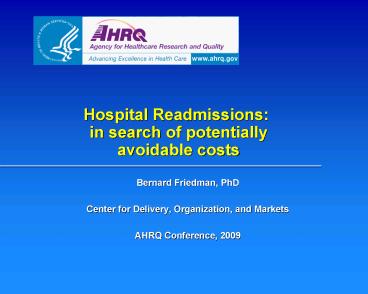Hospital Readmissions: in search of potentially avoidable costs - PowerPoint PPT Presentation
1 / 10
Title:
Hospital Readmissions: in search of potentially avoidable costs
Description:
One finding was that half of the discharges or hospital ... about 5 million adults were covered by the data. shows importance of the number of different chronic ... – PowerPoint PPT presentation
Number of Views:66
Avg rating:3.0/5.0
Title: Hospital Readmissions: in search of potentially avoidable costs
1
Hospital Readmissions in search of potentially
avoidable costs
- Bernard Friedman, PhD
- Center for Delivery, Organization, and Markets
- AHRQ Conference, 2009
2
Agenda
- Multiple uses of readmission data
- quality of inpatient care
- effectiveness of management of chronic illness
outside the hospital - efficiency in arrangements for post-hospital care
- accountability for health plans consumer choice
and P4P - Measurement choices depend on motives
- types of index admisssion, length of follow-up,
eligible readmissions - Tracking readmissions for the NHQR its
evolving - Recent research project Contrast Medicare FFS
vs. Advantage plan patients
3
Some AHRQ Published Studies on Readmissions
- 1.) Joanna Jiang was the lead author at AHRQ on
several published studies of diabetes discharges. - One finding was that half of the discharges or
hospital costs in a year are for people with
multiple discharges for diabetes and its
complications. - 2.) I examined (with Joy Basu) all readmissions
within 6 months for people with 16 Potentially
Preventable initial admissions. - Large variety of principal diagnoses for the
RE-admissions - Just the re-admissions in the 16 categories of
potentially preventable within 6 months had a
projected national cost of about 1.4 Billion in
2008. This covered only 4 states with 15 of
the U.S. population.
4
Readmissions and Quality of Inpatient Care
- 3.) William. Encinosa and Fred Hellinger
recently published The Impact of Medical Errors
on 90 Day Costs and Outcomes An Examination of
Surgical Patients. Health Services Research,
2008 - about 1.5 billion of cost in 3 months subsequent
to the initial discharge due to safety events.
Some of that was readmissions. - 4.) B. Friedman, J. Jiang, W. Encinosa, R.
Mutter, Do patient safety events contribute to
readmissions? Medical Care, 2009. - risk of a readmission within 1 month or 3 months
after a surgical admission was raised about 20
by a safety event.
5
Effective Management of Chronic Conditions
- 5.) B. Friedman, with Joanna Jiang and Anne
Elixhauser, - Costly Hospital Readmissions and Complex Chronic
Illness, Inquiry, Winter, 2008/2009 - about 5 million adults were covered by the data
- shows importance of the number of different
chronic conditions in predicting readmission
rates and annual cost. (complexity) - not easily fixed with disease-specific
management protocols. But there is literature on
demonstrations of other approaches. - 8 of the hospital costs for adults could be
saved if you could bring down the extra
readmissions for the 25 of hospitalized adulsts
with 5 or more chronic conditions. - There have been a couple dozen demonstration
projects of how to do that. It isnt free, of
course.
6
NHQR 2008 Readmissions
- Tracking system quality and system efficiency
- Congestive Heart Failure, readmission for same.
- readmission within 30 days (to any hospital)
- short enough to implicate the discharge planning,
handoff, patient counseling - not apportioning blame (could be other factors)
- the national burden of readmissions one person
can have more than one readmit during the year
qualifying to be counted (30 days from previous
admit). - comparison of states within age groups (big
difference between states, but not between age
groups)
7
Choices for future years NHQR
- Suggestions should go to Ernie Moy or Ryan or ...
- Possibilities
- multiple index admissions, with statistical
controls - readmission after elective treatment, after
delivery - state or area rates with risk adjustment.
8
Do Medicare Advantage Patients Have Fewer
Readmissions?
- Coauthors B. Friedman, J. Jiang, John Bott,
Claudia Steiner. - Database 5 states in HCUP with breakdown of
type of Medicare coverage and with person
identifiers. - Theory superficially, it seems that the
Advantage plans have both the motive (capitated
revenue) and the means to reduce readmissions in
comparison to FFS Medicare.
9
raw comparisons
- same 1-month rate of readmission (10)
- somewhat lower 3-month readmission rate (21 vs.
22.5). - However, Advantage patients tend to be
- a little younger
- less severely ill even when hospitalized
- less likely to have a major operative procedure.
10
Results
- Use risk adjustment and control for selection
bias (predictors for joining an Advantage plan) - Manuscript available on methods
- Advantage patients are one third more likely to
have a readmission (in 30 days, 13 vs. 10 in
90 days, 30.5 vs. 22.5). - How reconcile with incentives?
- maybe we did something wrong....
- enrollees have no comparative data
- FFS more discharges to LTC and other facilities
- Advantage plans might be spending less on
outpatient service and quality than we expected?































